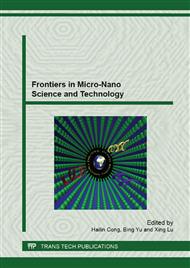[1]
Estola T, Makela P, Hovi T. The effect of air ionization on airborne transmission of experimental Newcastle disease virus infection in chickens [J]. Hygiene. 1979, 83: 59-67.
DOI: 10.1017/s0022172400025821
Google Scholar
[2]
Krueger A P. Air ions and physiological function [J]. GenPhysiol. 1962, 45 (4): 233-241.
Google Scholar
[3]
Krueger A P. The biological effects of air ions [J]. IntJBiometeor. 1985, 29 (3): 205-206.
Google Scholar
[4]
Li Z N. Negative air ions and hygiene. Ecol Sci. 1999, 18 (2): 87-90.
Google Scholar
[5]
Marin V, Moretti G, Rassu M. Effects of ionization of the air on some bacterial strains. Ann Ig. 1989, 1 (6): 1491-1500.
Google Scholar
[6]
Ryushi T, Kita I, Sakurai T, etc. The effect of exposure to negative air ions on the recovery of physiological responses after moderate endurance exercise. Int J Biometeorol. 1998, 41 (3): 132-136.
DOI: 10.1007/s004840050066
Google Scholar
[7]
Yao Chengsheng. The Yuelu Mountain aeroanion distributive law and the development and utilization of research [D]. Hunan normal university master degree thesis. (2005).
Google Scholar
[8]
Xia Lianbo. Beneficial to human health anion [J]. Popular Medicine. 1981, (7) :36-37.
Google Scholar
[9]
Liu Sujing, Zhou Qing. Ecotoxicological effects of the Rare Earths [J]. Journal of Chinese ecological agriculture. 2007, 15 (3): 187-190.
Google Scholar
[10]
Liu Zheng. Chinese soil trace elements [M]. Jiangsu Science and Technology Press. 1996. 295.
Google Scholar
[11]
Li Shujie, DouSen, Wang Limin, Liu Zhaoshun. Geochemical Characteristics of Rare Earth Elements on Sunflower Growing Area in the West of Jilin Province [J]. Environmental Science. 2011, 32 (7): 2081-(2086).
Google Scholar
[12]
Wu Jing, Feng Xiujuan. Progress in the Plant Ecological Effects of Rare Earth Elements [J]. China Resources Comprehensive Utilization. 2012, 30 (4): 37-40.
Google Scholar
[13]
Li Xiaofei, Chen Zhibiao, Zhang Yonghe, Chen Zhiqiang. Concentrations and health risk assessment of rare earth elements in soil and vegetables from a mining area in Fujian Province. Acta Scientiae Circumstantiae. 2013, 33 (3): 835-842.
DOI: 10.1016/j.chemosphere.2013.06.085
Google Scholar
[14]
Tang Jiahong, Liu Dan, Yang Yu-lan, Li Wen, Chen Guoxiang. Effect of re e and no on Some Photosynthetic-characteristic in Wheat under Drought Stress [J]. Chinese Rare Earths. 2012, 33 (3): 21-25.
Google Scholar
[15]
Wu Lili, Gao Yongsheng, Huang Weifeng, Song Haishui. Effects of Eu3+ on Anthocyanin Content and PAL Activity in Potted Photinia fraseri under Different Light Intensity [J]. Journal of the Chinese rare earth society. 2011, 29 (2): 217-222.
Google Scholar


